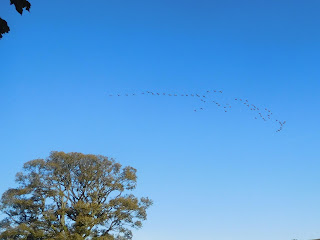To Cumbria, for a little pre-winter break, hoping for some leaf-peeping and fell walking. We took the train, challenging ourselves to pack all we needed for the week into carry-on suitcases so that we could cope with the underground.
Rule one of any trip: always expect the unexpected. My husband had booked the hire car from the branch of the firm nearest to the road south we needed to take. Arriving at Carlisle, we climbed into a taxi. The driver shook his head: that branch looked as though it had closed down. We went to check and his information was correct. I'm still astounded that a national car hire firm would take a booking for that location but not bother to inform the hirer that their business had transferred to the other side of town.
And there was more. One of our pleasures while in Maryport is to go for a drive up the coast, something we cannot do so easily in Essex. So we were dismayed to find that the road up to Allonby was closed for repairs, necessitating longish detours by the inland villages to reach the coastline.
But, these problems notwithstanding, we had a relaxing week with weather good enough to enjoy our regular walks in rotation.
On the best day it was along the shore of Loweswater, up through the mixed woodland and out on to the high path above, all the while enjoying the autumnal sunshine.
The lake was about as calm as we have ever seen it.
Another day we drove to Keswick to buy some wet weather gear, then down past Thirlmere to Grasmere. Sarah Nelson's gingerbread shop was doing roaring trade.
We were there to see the exhibition "This Girl Did" at the Wordsworth museum. Given that Dorothy Wordsworth was 46 at the time that she ascended Scafell, the term "Girl" is pushing it a bit, but of course her long-distance walking had been habitual.
Saturday was both windy and rainy but we had determined to make the most of our time, so off we went: through Lanthwaite woods to Crummock. The views from Crummock shore were obscured but we enjoyed the walk nonetheless.









































.JPG)